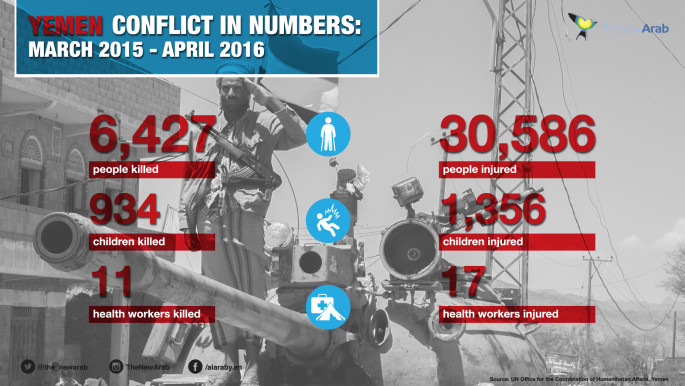Yemen's war: Thousands dead, millions displaced, billions in damage
The war, which began when Saudi Arabia formed a coalition to battle rebels following their September 2014 coup, has caused extreme damage to the country’s infrastructure, the joint World Bank, United Nations, Islamic Development Bank and European Union report said.
"The conflict has so far resulted in damage costs (still partial and incomplete) of almost $7 billion and economic losses (in nominal terms) of over $7.3 billion in relation to production and service delivery," it said, according to Reuters.
The UN says that more than 6,400 people, mostly civilians, have been killed in Yemen since the coalition air campaign began last March.
The fighting has also driven 2.8 million people from their homes and left more than 80 percent of the population in the region’s poorest nation, needing humanitarian aid.
The numbers have forced the international community to describe the conflict as a "humanitarian catastrophe" with rights group calling for the immediate end of military airstrikes as well as blocking arms export to Saudi Arabia.
The Preliminary Damage and Needs Assessment report, which was conducted between late 2015 and early this year, suggests "these preliminary findings are not only partial, but also evolving" due to the developments in the ongoing conflict.
"There has been a surge in civilian morbidity and mortality as an indirect consequence of the conflict," the report said, just days after losses were recorded on both sides of the Yemeni-Saudi border.
 |
There has been a surge in civilian morbidity and mortality as an indirect consequence of the conflict |  |
Data collected from Sanaa, Aden, Taiz and Zinjibar found an estimated $3.6 billion in residential damage – areas which saw high levels of military airstrikes and clashes between warring factions on the ground.
Energy facilities damaged in the mentioned cities are expected to cost $139 million in repairs, the report said.
Meanwhile a governmental report conducted by Yemen’s education ministry confirmed 1,671 damaged schools now stand in 20 governorates, 287 need major reconstruction, while 544 were serving as shelters for internally displaced persons, and 33 were occupied by armed groups.
 |
1,671 damaged schools now stand in 20 governorates, 287 need major reconstruction, while 544 were serving as shelters for internally displaced persons, and 33 were occupied by armed groups |  |
The government report said an estimated 2.6 million children under 15 are at risk of contracting measles, with only 900 of 3,652 vaccination facilities operating in early 2016.
In Yemen's third-largest city Taiz, the public health system has nearly collapsed, with half the public hospitals damaged or inaccessible.
"There has been a surge in civilian morbidity and mortality as an indirect consequence of the conflict," the report said.
Immediate attention must be refocused on the country’s import financing, the report proposes, as the government continues to accuse its national bank of misusing state funds.
"As long as the conflict is ongoing, it's key to keep going the basic imports needed to avoid a humanitarian crisis. That is a very critical issue right now," the IMF's Yemen Mission Chief Albert Jaeger told Reuters.
"The best the international community and donors can do is to find a way to get the government and the central bank to cooperate to get at least the humanitarian side of things going."
 |
The best the international community and donors can do is to find a way to get the government and the central bank to cooperate to get at least the humanitarian side of things going |  |
Despite the concerns, the Saudi-led coalition has intensified its air raids in Yemen recently, killing more than 270 and injuring 543 between April and August 2016, including strikes on schools and hospitals in the past four days.
On Tuesday, Houthis responded with one of the deadliest episodes of cross-border shelling that left residents in the Saudi city of Najran in a state of panic after seven civilians were killed.
The Houthis overran the capital in late 2014 before moving into other parts of Yemen, prompting Saudi Arabia to form an Arab coalition to launch a military campaign in an attempt to reinstate the government of Abdrabbuh Mansour Hadi.
 |
|





 Follow the Middle East's top stories in English at The New Arab on Google News
Follow the Middle East's top stories in English at The New Arab on Google News


